SU fire engineers explore risks for humans and dwellings
Jorisna Bonthuys
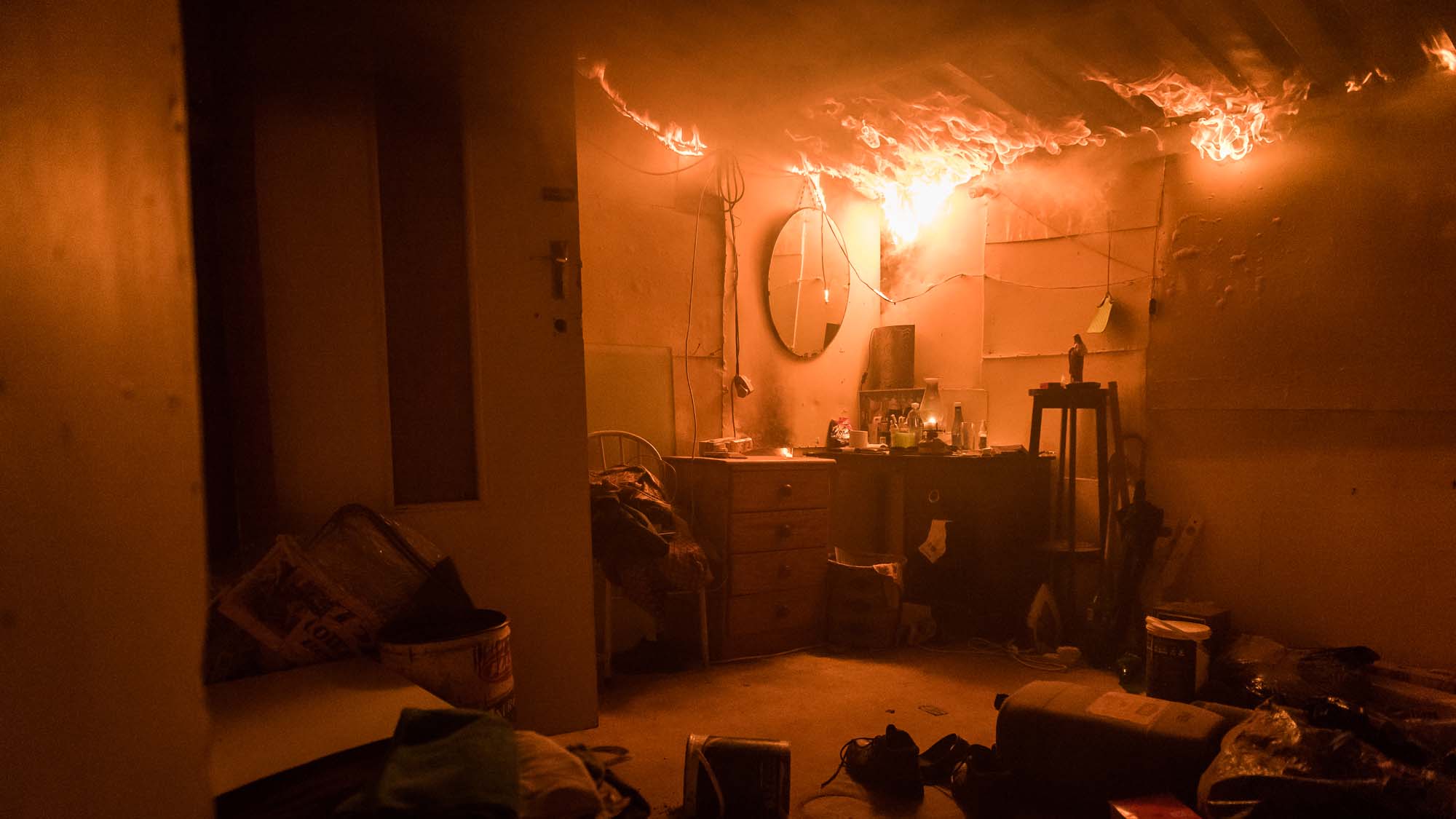
According to statistics, up to 115 people die annually due to fires in Cape Town’s informal settlements.
The city is known as the "fire capital" of South Africa due to its high number of fire-related incidents, recorded with its effective data collection systems. Other cities could potentially have higher death rates but often have incomplete fire incident data.
Fires leave countless people homeless in the metropolitan area. Annually, 4 500 dwellings are damaged or destroyed, shattering many communities. And this destruction is not limited to Cape Town.
The recent fire incident in Johannesburg, in which at least 77 people died and hundreds were left homeless, clearly illustrates the sweeping extent of fire risk across the country.
Apart from the lives lost, the more than 40 000 fires reported in South Africa annually translate to roughly R4 billion in financial losses. (Last year, the South African government reportedly added another R2 billion to this fire tag after the South African parliament building in Cape Town was gutted in January.)
“As a society, we need to understand how fires spread if we are to prevent them from becoming total disasters,” says Prof Richard Walls, who heads up the fire engineering team, FireSUN, at Stellenbosch University (SU). “Urban fires can be incredibly dangerous, particularly in informal settlements.”
Established in SU’s Department of Civil Engineering, FireSUN is training the next generation of fire safety experts. In 2019, the university launched its master’s and PhD degree programmes in fire safety engineering — the first academic offerings of their kind on the African continent. In 2024, an online masters degree is being launched to train engineers across South Africa and the developing world.
A place to dwell
In 2022, South Africa had more than 2 700 informal settlements, most of them located on land that is unsuitable for property development and prone to housing emergencies. Across the country, an estimated 7,6 million people live in primary dwellings and the so-called “backyard dwellings” behind them in informal settlements.
These settlements are dense, unplanned, and ramshackle, typically housing low-income communities. Most of the homes are make-shift enclosures ("shacks") cobbled together from corrugated-iron and plastic sheets, as well as wooden materials. And their numbers are growing.
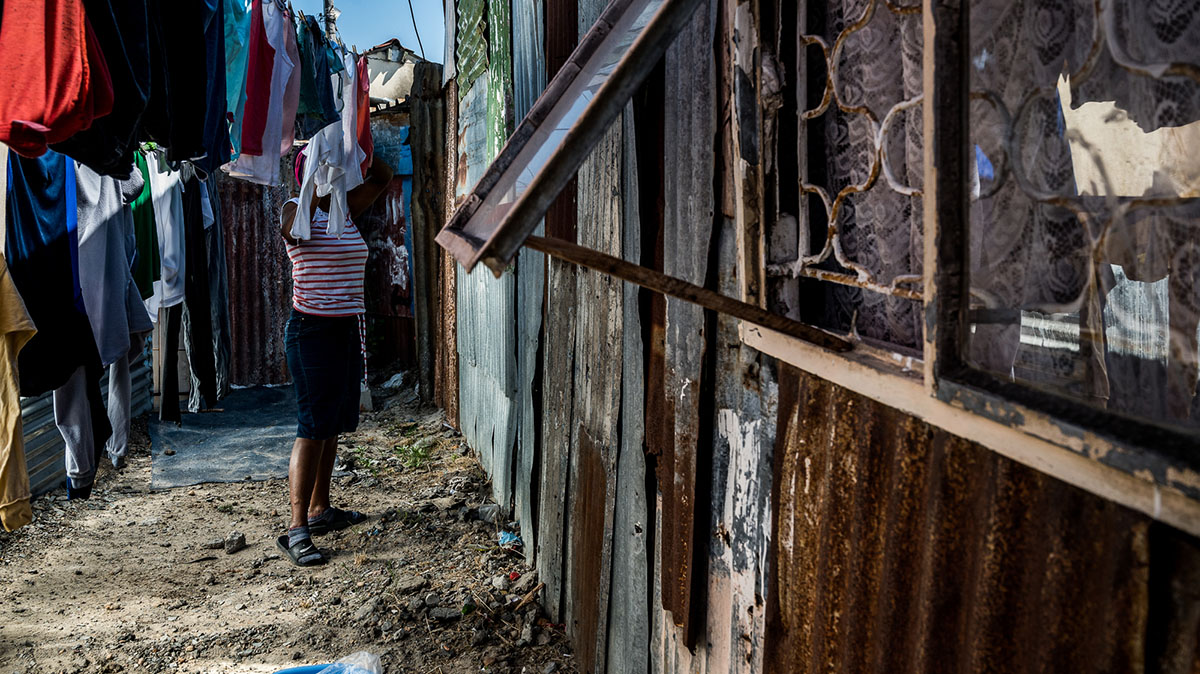
Approximately one in every five Western Cape and Gauteng households have their homes in informal dwellings like this one in Khayelitsha Site B, Cape Town. | Photo by Newton Stanford
“Whether we like it or not, we live in flammable cities with high densities and many flammable buildings,” Walls says. “The consequences of urban fires are often devastating — but preventable.”
All sorts of things can start fires in informal settlements, from open flames and dodgy electrical setups to a variety of other causes. Climate change has also made fire-prone weather conditions twice as likely in Cape Town today than in the late 1970s. A recent attribution study showed that the extreme, destructive wildfire of April 2021 on the slopes of Devil’s Peak has become around 90% more likely in a warmer world.
In holistic fire management, Walls says, both understanding fire behaviour (the physics of why things burn) and fire safety engineering (design approaches that improve fire safety) are crucial.
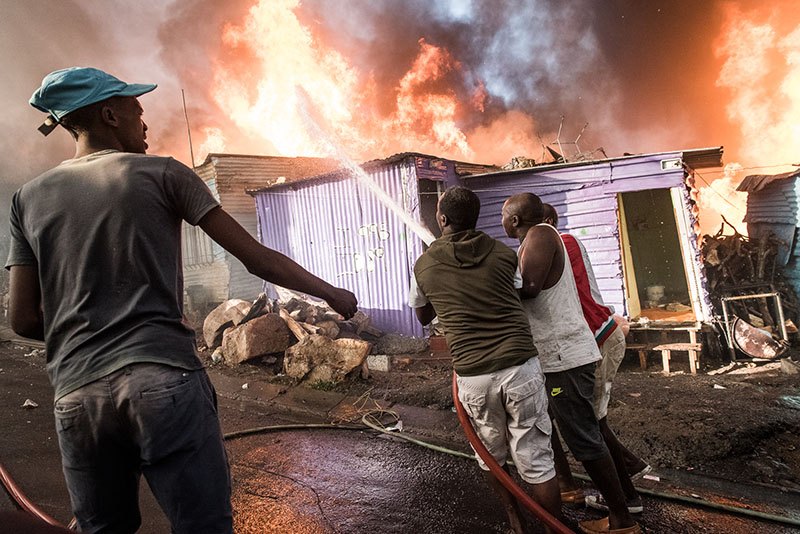
Access to communal water supply is essential for fighting fires in informal settlements. Picture taken in Imizamo Yetho in Hout Bay in 2017, when more than 3 000 homes were gutted. | Photo by Justin Sullivan
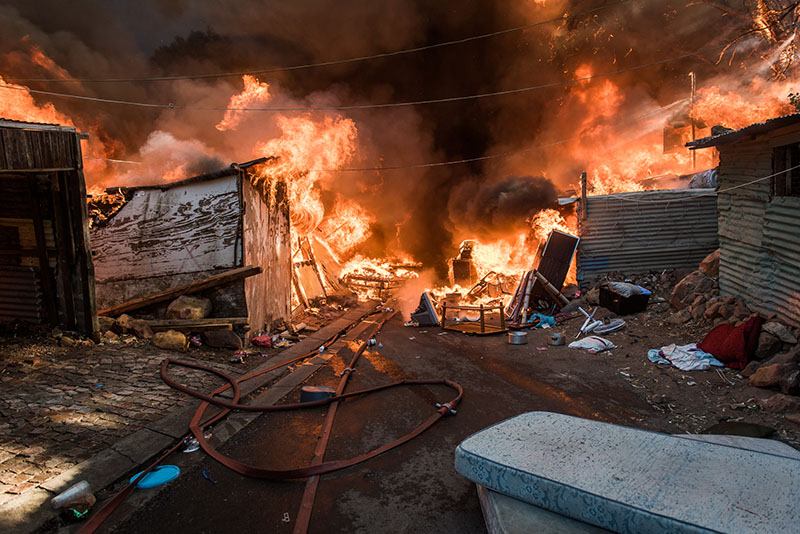
Fires move very quickly through areas where homes are situated close together. | Photo by Justin Sullivan
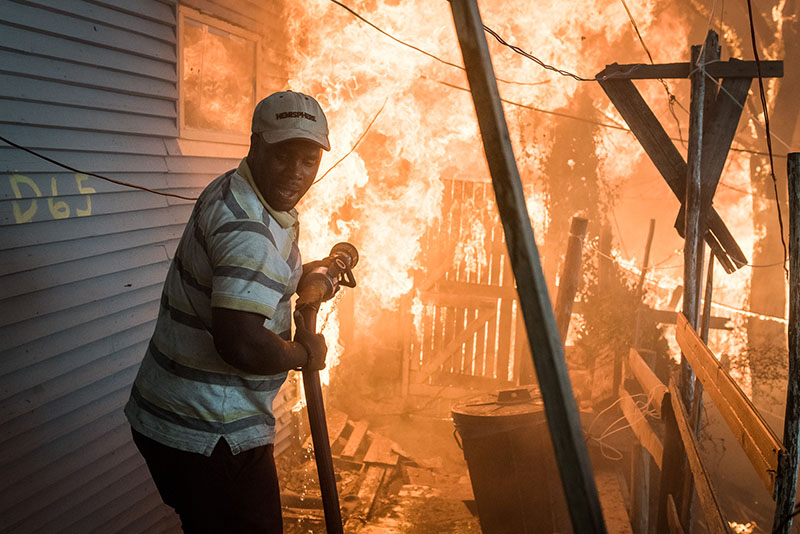
There is no one-size-fits-all method, material, or gadget to make informal settlements and backyard dwellings fire safe. However, understanding how fire behaves, how homes ignite, what makes an area a high risk one, and what happens during a fire incident will help make communities safer. | Photo by Justin Sullivan
Engineering for change
Before joining SU as a lecturer and researcher, Walls worked as a structural engineer designing industrial, petrochemical, and commercial buildings.
“I became involved with fire safety engineering by accident during my PhD studies at SU,” he says. “At the time, my study leader [in civil engineering] suggested I focus on fire safety and steel structures. I soon realised there is a massive gap in this field and became interested in the teaching aspects of it.”
But Walls’ connection with communities affected by fire started much earlier. As an 18-year-old student, he volunteered at a soup kitchen in Braamfontein (Johannesburg) called Paballo Ya Batho, and at Children of Fire, a charity working with young fire survivors.
These experiences made him aware of the hardship caused by the legacy of fires for both individuals and households. Today, he wants to bring fire-related risks and safety issues to the fore to help make our cities and informal settlements more fire resistant.
In 2020, Walls was awarded the NSTF-South32 national prize for emerging researcher of the year, and in 2021, the IStructE Excellence in Structural Engineering Education Award. This international award celebrates innovative and effective teaching techniques to improve student learning at a tertiary level.
Walls serves on the research advisory board for the National Fire Protection Association (a US-based non-profit organisation) and is a member of the SABS working group for fire engineering codes.
He works closely with fire services to develop solutions for local fire challenges, embraces innovative approaches to engineering education, and engages on the global stage to help find practical solutions for complex fire problems.
Moreover, Walls was instrumental in developing the Fire safety engineering guideline for informal settlements, a project co-funded by Lloyd’s Register Foundation, for the Western Cape Department of Human Settlements. These guidelines were formulated in a collaborative effort between FireSUN, the Research Alliance for Disaster and Risk Reduction (RADAR), the Milnerton Fire Brigade, and Kindling (a US-based non-profit fire safety organisation). This is the world’s first set of technical guidelines on fire safety in informal settlements, supported by a series of online training videos.
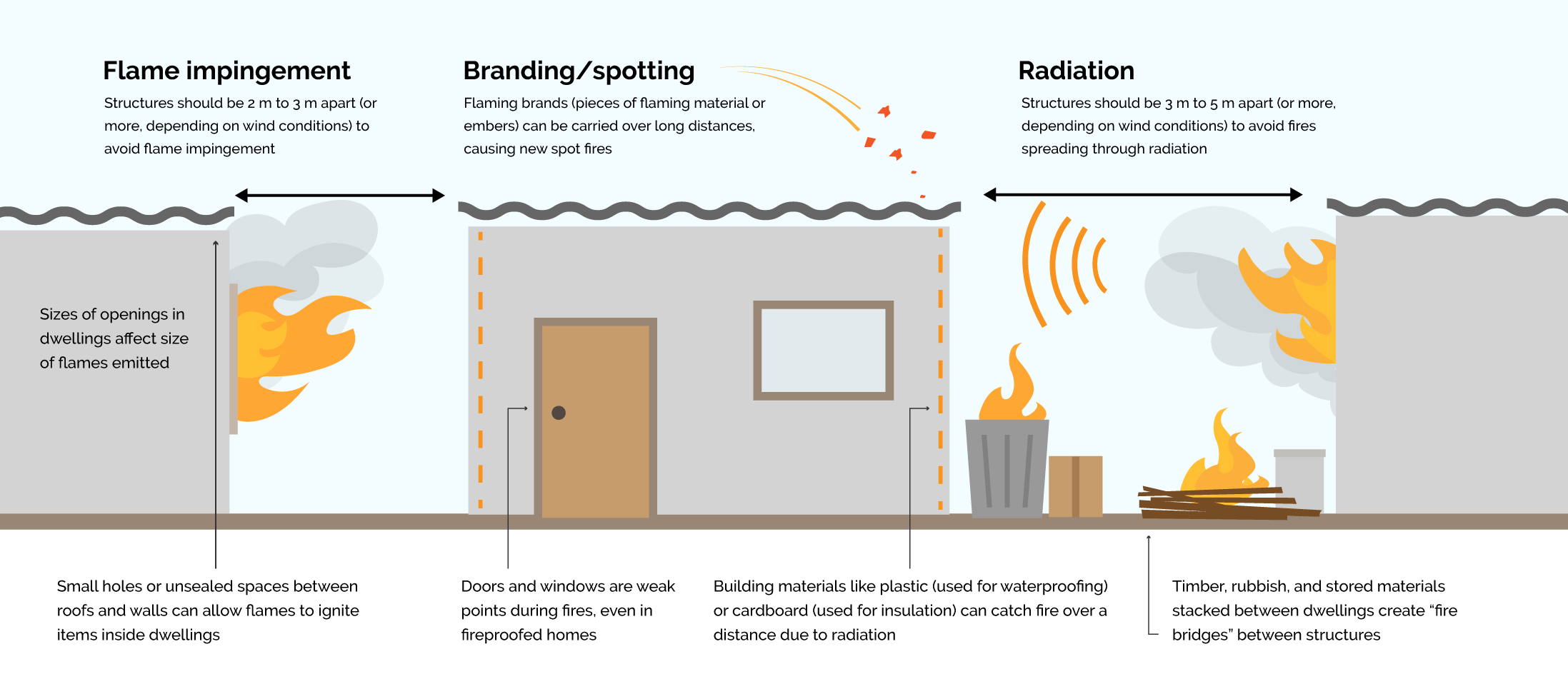
Illustration showing how informal dwellings catch fire from flame impingement (left), branding/spotting (middle), and radiation (right) Comment end | Image courtesy of FireSUN Publications
The science of fire
South Africa has one of the highest incidences of fire-related casualties in the world. Daily, at least 30 fires are recorded in informal settlements across the country, accounting for at least one person’s death per day. Yet, little is known about such fires’ triggers, incidence, and impacts.
With this in mind, FireSUN has done experiments to determine how fires spread and how fast this happens in informal settlements. Over the years, Walls and his students have burned down more than 70 life-sized dwellings.
Some of this research was done in 2018 as part of the world’s largest informal settlement fire experiment to date. Twenty full-scale homes were set up, fitted with instruments, and burnt down to try to understand the spread of fires between dwellings in informal settlements. The results of this research, conducted with collaborators from the University of Edinburgh (Scotland) and the Breede Valley Fire Department, were published in Fire Technology.
Even with a relatively mild wind speed of 15 to 25 km/h, common in Cape Town’s metropolitan area and adjacent regions, the fire spread through the mock settlement within five minutes.
The research team knew that the burning dwellings would act as tinderboxes, igniting nearby structures. Following the ignition of a shack, the engulfing of the entire dwelling in flames, or "flashover", happens extremely fast. The experiment revealed the sheer speed at which this happens: Temperatures reached more than 1 000 °C within a minute and downwind neighbouring structures ignited less than a minute after that.
According to Walls, fire behaviour in informal settlements differs significantly from that in formal-building fires. When a fire rips through an informal settlement, this is analogous to a wildfire with a continuous firefront moving through a natural area. While the individual dwellings still follow the distinct phases of enclosure fires, they collapse faster than formal structures.
Many factors influence the spread of fire, including the building materials used.
At FireSUN, researchers consider how different construction materials behave when burning. For instance, Dr Antonio Cicione and others have investigated the effect of fire on cladding materials (specifically timber versus steel cladding, often used in informal settlements). An important finding of this study was that separation is critical: A gap of roughly three to five metres between dwellings is necessary to prevent the spread of fire between them. Cicione, an adjunct senior lecturer in structural fire engineering at SU, is also the founder of CFS Engineering Consultants and the fire safety engineering lead at Kindling
Wildfires and the urban edge
Fire is an important ecological driver in many ecosystems, including the Greater Cape Floristic Region. Natural vegetation in this biodiversity hotspot must burn at certain intervals in order to rejuvenate. But uncontrolled wildfires (“veld fires”) pose a risk to lives, livelihoods, property, and the natural environment.
This fact was underlined by the recent devastating wildfire that incinerated many of the coastal settlements on Maui, Hawaii, in August 2023. It was declared the deadliest US wildfire in more than a century, and destroyed much of the historic town of Lāhainā. At least 114 people died, and hundreds more are unaccounted for. Hawaii is increasingly under siege from natural disasters, and what is escalating most is wildfire.
Locally, the 2017 Knysna fire disaster also provided urban planners, researchers, and decision-makers alike with much food for thought. Several points of ignition and severe climatic and meteorological conditions (including storm winds of more than 90 km/h) led to this event, considered South Africa’s largest ever wildfire disaster in terms of structural and economic losses. “With close to 1 000 homes destroyed and billions of rands worth of damage, it is important that we understand this and similar incidents,” Walls says.“ Firebrands (small flaming particles) jumped distances of up to 2,8 km
Under the leadership of postdoctoral researcher Dr Natalia Flores Quiroz, SU researchers investigated the Knysna event in detail, including how the fire spread and the influence of vegetation and weather. Their findings were published in the journal International Journal of Disaster Risk Reduction.
According to the researchers, regional drought and other weather conditions impacted fire suppression, with high wind speeds and critically low humidity contributing to the ignition of several secondary fires. Flames jumped distances of up to 2,8 km under these conditions. The blaze was also fueled by old stands of invasive alien species, as well as combustible materials like thatch and timber, which made some homes more susceptible to fire damage than others.
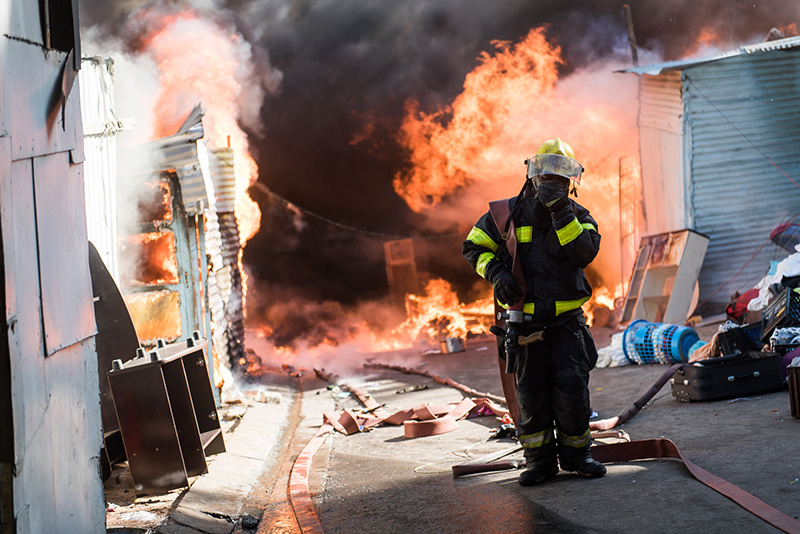
A variety of unregulated construction methods and materials are used to build informal dwellings. | Photo by Justin Sullivan
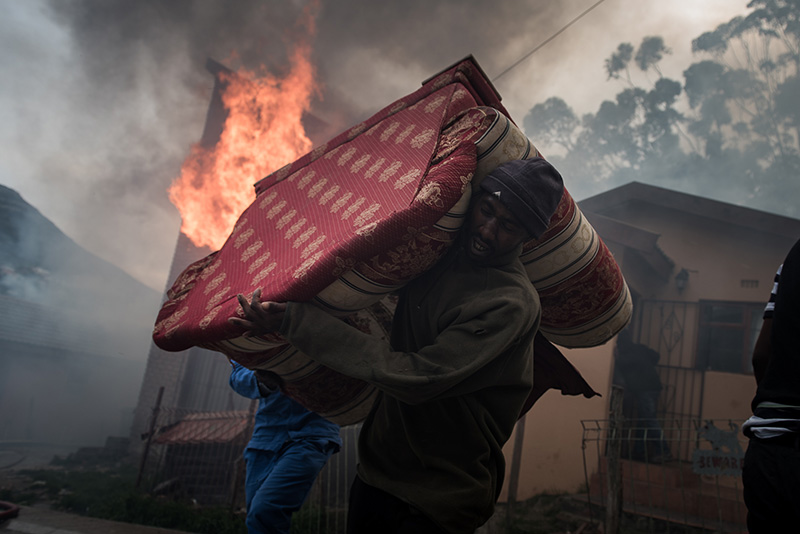
During dry seasons and droughts fires spread faster. However, many smaller fires also occur in wet weather form indoor cooking and heating. | Photo by Justin Sullivan
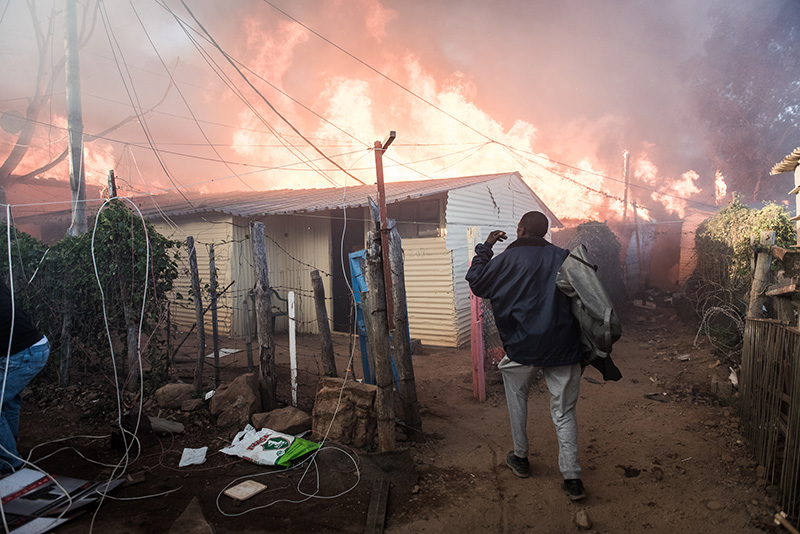
Understanding large-scale disasters
Over 95% of reported fire deaths and burn injuries occur in low- and middle-income countries in the Middle East, Asia, and Africa, said Dr Danielle Antonellis, an extraordinary staff member of FireSUN, in a recent webinar. Antonellis, also the founder and executive director of Kindling, received the International Fire Safety Woman of the Year Award in 2022 from Women in Fire Safety.
Urban fires disproportionately impact people, property, and livelihoods in vulnerable communities, she said. In informal settlements, fire investigations are often not conducted, and close to 40% of all fire causes are labelled as “undetermined”.
Often, a lack of evidence at the scene hinders fire investigations. With this fact in mind, Flores Quiroz developed a framework for fire investigations in informal settlements, which was published in the Fire Safety Journal. Although the data for this study was collected in Cape Town, South Africa, the lessons learnt can be applied elsewhere across the globe.
Fire risks are also acute in high-density refugee camps, including the Cox’s Bazar camp in Bangladesh. In March 2023, an estimated 15 000 Rohingya refugees from Myanmar were left without shelter after a fire tore through Camp 11 of the larger camp, destroying 2 800 shelters, as well as several mosques and learning centres. The Cox’s Bazar camp houses almost 1 million people overall, making it the world’s largest and most populated refugee camp.
Flores Quiroz and Walls have been involved in international collaborations to understand fire risks in Camp 11 to better inform humanitarian efforts. After working closely with the Migrant Offshore Aid Station and fire engineers from the University of Maryland, they provided guidance to disaster agencies working in the camp, including the UN Refugee Agency.
Together, the researchers reconstructed the most recent disaster incident — from the fire, all the way through to the response and evacuation — based on firefighters’ statements, media reports, and satellite imagery. Their findings were published in the the journal Fire Technology Journal.
This is the first detailed documentation of such a large-scale refugee camp incident in the academic literature and is especially relevant at a time when global displacement is on the rise.
Forensic investigations
It is necessary to understand large-scale fire incidents and have data on grounds of which evidence-based interventions can be developed. “We cannot prevent these fires from happening altogether, but we can prepare for them and reduce potential impacts,” Walls emphasises.
Fire investigations are often complex due to factors like material type, weather, and fuel loads, which should all be considered. In recent years, FireSUN’s team has participated in several high-profile studies.
Cicione and Antonellis were involved in investigations of the devastating 2020 Beirut explosion, which ripped through the city, destroying 70 000 homes and leaving 200 people dead and over 300 000 homeless. Forensic investigations of the event have cast doubt on the widespread claims that Syrian welders’ shoddy work is to blame for the fire that triggered the blast. In 2023, Forensic Architecture released an analysis of the port explosion based on leaked documents and Kindling fire dynamics simulations. The report showed that the detonation was likely caused by vast quantities of ammonium nitrate that were improperly stored in a warehouse in the port, and that the work of the Syrian welders was unlikely the cause of ignition. The modelling for this research, analysed by Forensic Architecture, was done on SU’s computers.
In recent years, fires such as that at the South African parliament in 2022 and at the Charlotte Maxeke Hospital in Johannesburg in 2021 have reportedly caused the South African government and parastatals direct losses of between R5 billion and R10 billion. Sections of the hospital, one of the biggest in the country, were closed for months, causing a disruption to the provision of healthcare services in Gauteng. FireSUN researchers subsequently examined the effect of these fires on critical infrastructure and have been involved in reconstructing the hospital.
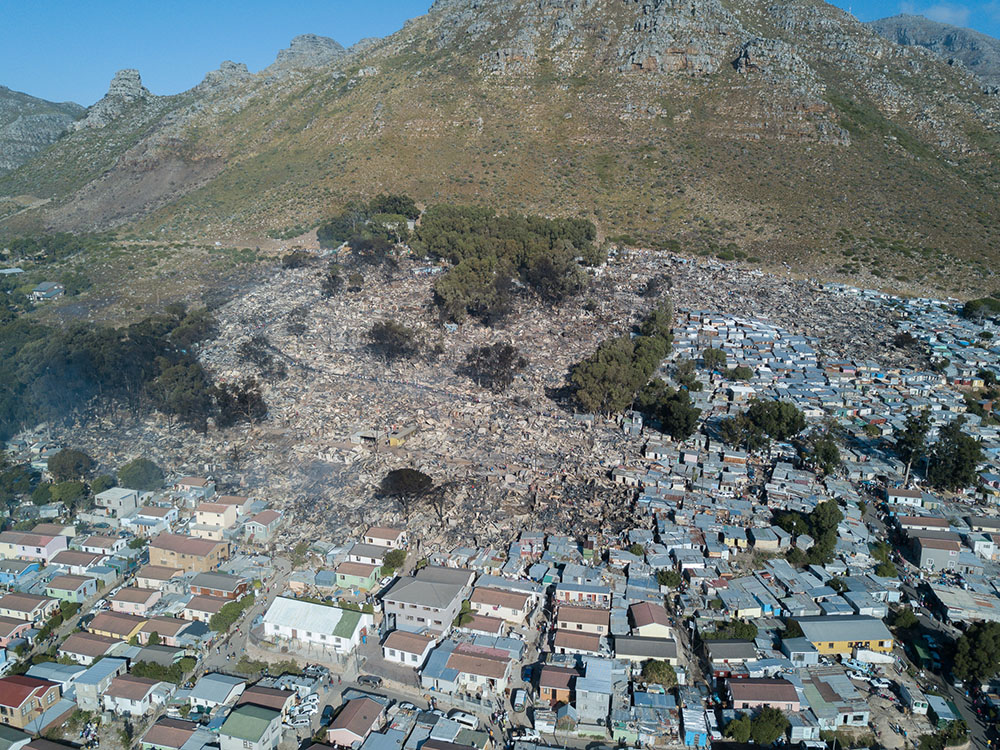
The risk that urban fires will cause trauma, injury, or death is exceptionally high for people living within informal settlements. Aerial image taken after the fire in Imizamo Yetho in Hout Bay in 2017. | Photo by Justin Sullivan
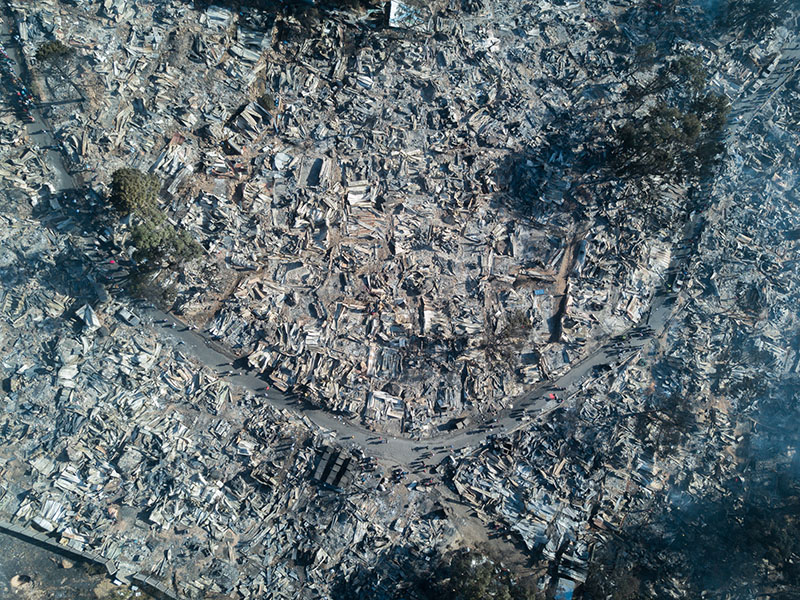
Aerial image of Imizamo Yetho in 2017, showing the devastation caused by the fire | Photo by Justin Sullivan
What is more flammable, peanuts or wood?
FireSUN’s researchers are exploring several fire-related topics, such as the effect of fire on 3D-printed concrete and fire safety challenges related to "green"buildings. “In our unit, we’ve burned all sorts of weird and wonderful things,” Walls says. These investigations range from testing how flammable train seats are to determining the fire risks involved in using eco-bricks and storing peanuts in warehouses.
Anene Oguaka focused his recent PhD dissertation on the fire behaviour of bulk African foodstuffs, with the purpose of advancing food safety. In 2023, based on this experimental research, he published an article, co-authored by Walls and Flores Quiroz, in the journal Process Safety and Environmental Protection.
The researchers considered the fire hazard of food grains being stored in warehouses. Oven-dried cowpeas, lentils, millet, soybeans, flax seed (linseed), peanuts, and sunflower and sesame seeds were subjected to different heat fluxes.
Their findings show some grains, including peanuts, to have a higher fire hazard than even wood pellets. “This means there are fire risks in large storage units which, in turn, pose a risk to food security in our region,” Walls explains.
Greening the future
Materials used in the construction of buildings account for around 9% of overall energy-related carbon emissions, according to UNEP. Moreover, of the projected African building stock in 2040, an estimated 70% is yet to be built. With this in mind, the sector is looking at alternative materials and at decarbonising conventional materials such as cement.
However, one of the biggest barriers to sustainable construction is fire safety, Walls points out. Green intentions and fire safety do not necessarily align — rigorous testing of products and materials is necessary.
“Green buildings pose their own fire risk challenge,” Walls says. “This is because many of the ecologically sustainable products on the market used to, for instance, insulate these buildings are made of biomass or waste, which is normally oil-based.
“In many of the novel sustainable [building] products, one of the main barriers to commercialisation is fire. Overseas, 18-storey timber structures are being built in a move away from using traditional building materials with a large carbon footprint. But are these buildings posing fire risks? If so, how can we design and build them in a way that reduces that risk?”
As the demand for exposed structural timber continues to grow, it’s becoming increasingly important to understand how these structures will behave in the event of a fire. This means paying close attention to the structural connections and ensuring they are designed to withstand heat and flames. FireSUN is involved in developing biomass-based fire protection systems, including coatings on timber for fire protection.
Going forward, FireSUN’s researchers will consider the fire-resistance rating of different materials, including local plywood. The unit is also investigating the use of fire-resistant timber as a construction material in high-rise buildings in high-rise buildings.
Solutions, not gadgets needed
Engineering solutions can help sort out many fire-related issues in the urban landscape, Walls says. “From alarms to fire trucks — a lot can be done to improve our responses to fires in informal settlements.
“Many issues related to fire risk and safety come back to [applying] common sense. Often, fire safety is not the focus of decision-makers who must provide people with homes, roads, electricity, and water. But by providing these things, we can also improve fire safety in informal settlements.
“So, while we upgrade settlements, we can reduce risk by not using highly combustible building materials. Putting in new roads and water infrastructure can help when we need a fire break.”
It is crucial to consider the practicalities and challenges associated with a large-scale rollout of the solutions offered. “Too often, one-size-fits-all ‘solutions’ are offered to mayors and city officials. Some of these solutions are inappropriate and not as effective as promised.
“Our job [at the unit] entails testing new technologies and providing decision-makers with scientifically proven facts to inform their decisions about implementing solutions.
“Also, sometimes the best solutions for a specific community are not highly scientific. People might, for instance, simply need buckets with sand or water sources in the right place, which can make all the difference during a fire event.
“We need solutions, not gadgets,” he emphasises.
“The ideal situation would be to provide people with safer, code-compliant homes, but resources are limited. However, there is still a lot that authorities can do to reduce fire risks.”
Walls believes fire and structural engineers can help make towns and cities more fire resistant and ultimately help provide a roadmap for making living spaces safer for local communities.
“Understanding fire behaviour is vital,” he says. “Before you try out interventions [to improve fire safety], ask yourself if it has been tested in local communities and in a technical environment.”
In this regard, he believes FireSUN’s work could pave the way to more fire-resilient infrastructure choices and investments. “We need to learn how to make buildings safer by seeing what can go wrong. How man
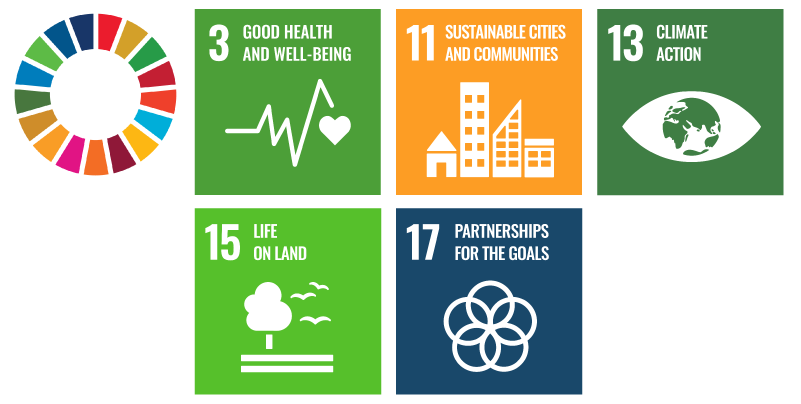
The research initiatives reported on above are geared towards addressing the United Nations’ Sustainable Development Goals numbers 3, 11, 13, 15, and 17, and goal number 1, 2, and 7 of the African Union’s Agenda 2063.
Useful links
Faces of the future in fire protection in the developing world
Prof Walls helps to keep homes and informal settlements fire safe
Imizama Yethu: A fire that killed 4, destroyed 2 194 homes and displaced 9 700 people
Informal settlement fires documentary: Smoke Alarms
We need solutions, not gadgets
Prof Richard Wall’s inaugural lecture
Twitter: @MatiesResearch and @StellenboschUni